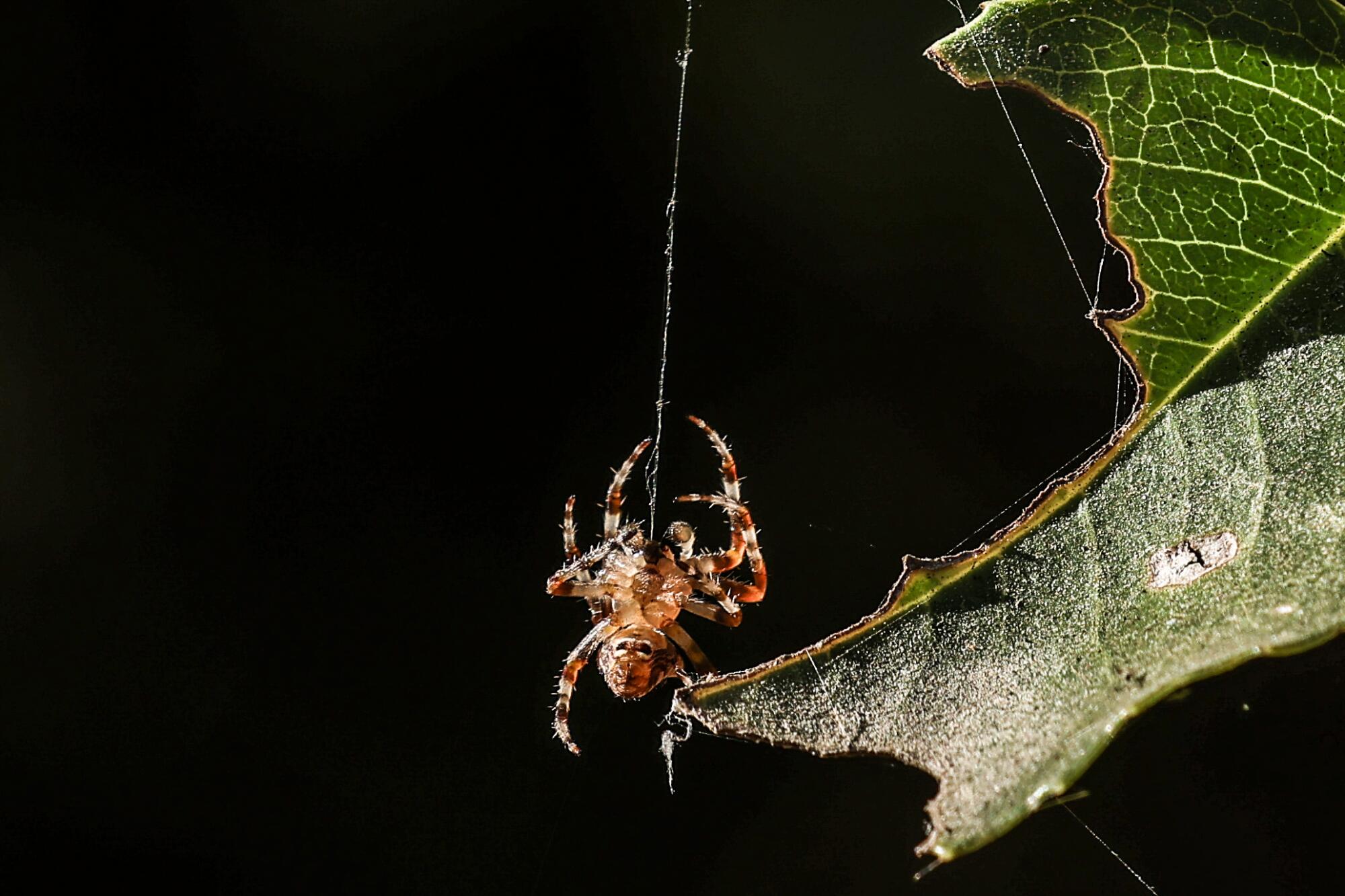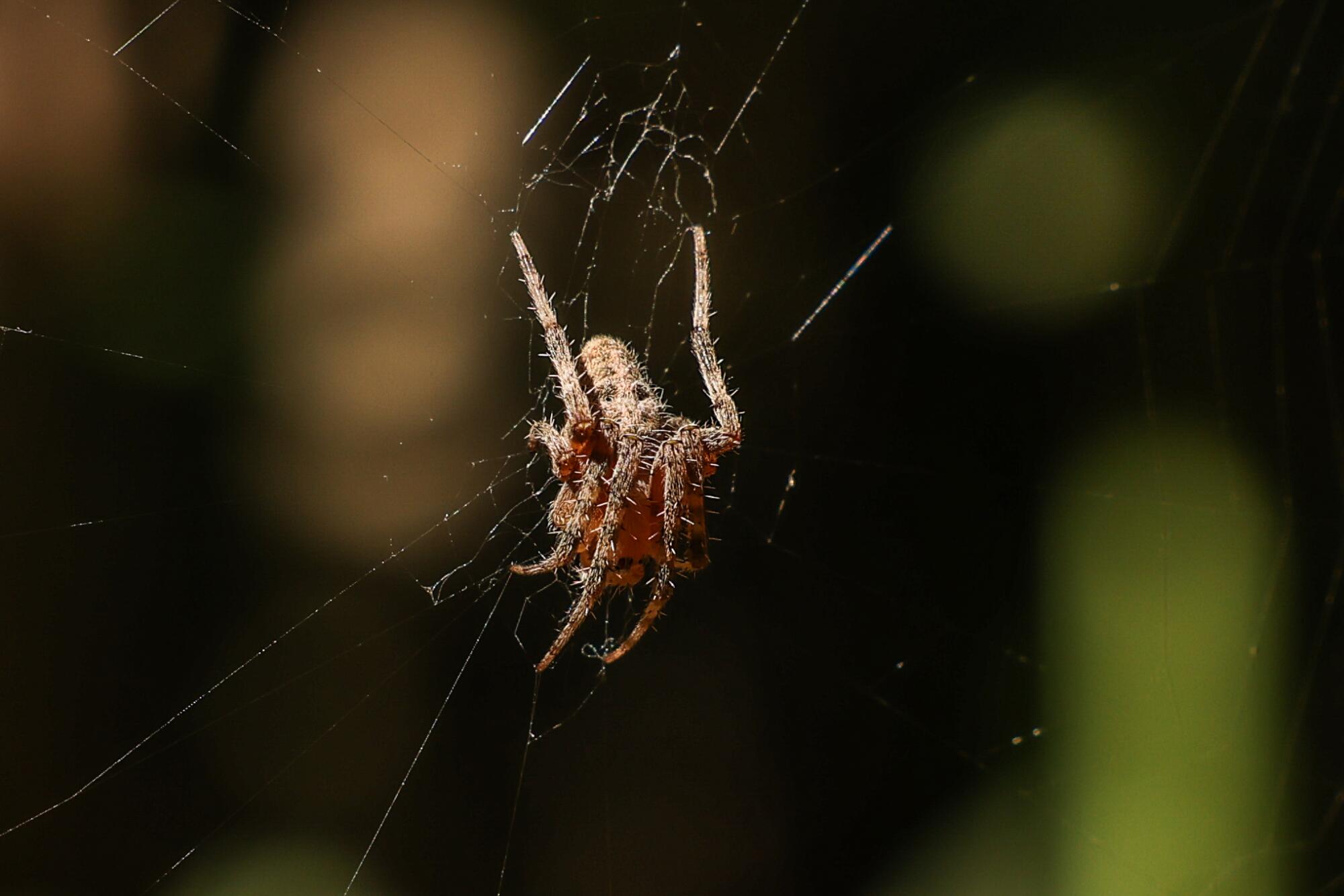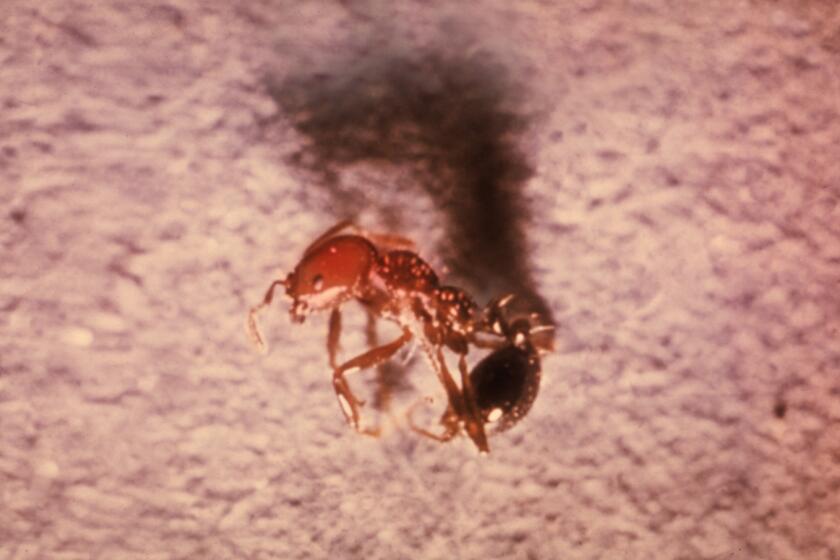
- Share via
Move over, dogs. We’re entering the spider days of summer.
When it warms up, spiders come out of their hidey-holes. Not to tan, but to catch their bread and butter: bugs.
Aggressive and impactful reporting on climate change, the environment, health and science.
The arachnid awakening is part of a cascade of weather-dependent events, explained Lisa Gonzalez, program manager of invertebrates for L.A. County’s Natural History Museum, who oversees the museum’s Spider Pavilion among other bug-centric attractions.
When the sun shines — particularly after a good amount of rain — plants pop off, and in turn insects do too. Everything that feeds on insects benefits, including spiders.
“So if you see an increase in insect activity, which would coincide with warmer temperatures and more plant growth, then you’re going to see more spiders thriving and being present,” Gonzalez said.
Southern California saw an extreme example of this phenomenon last year after torrential downpours, including a highly unusual tropical summer storm. Unfortunately for Angelenos, mosquitoes were among the insects that took off in the aftermath.
Big Santa Anita Canyon, a beloved hiking area above Arcadia shuttered for years, is slated to open this fall. Some fear a lack of bathrooms means poop will pile up.
The spiders’ emergence in the warmer months follows a period of hunkering down, which can make it feel dramatic. Suddenly, webs seem to line every window frame and hover in midair — threatening you with a mouthful of silk.
Arachnids are low-key in the winter because there aren’t many juicy flies and butterflies flapping about.
“There’s no sense making a web … if there’s nothing to eat,” said Rick Vetter, a retired research associate in UC Riverside’s entomology department. “You don’t go fishing where there’s no fish.” (A Google image search for Vetter brings up a photo of a hefty tarantula hanging out on his face, so you can trust his expertise in arachnid matters.)
Silk, what the spiders make to build their webs, is “energetically important,” Vetter added, so spiders won’t go wasting it during cold months when prey is scarce.
They’re also cold-blooded animals. When it’s chilly, they chill out to conserve energy — going into a type of insect hibernation called overwintering, Gonzalez said.
“Spiders in particular can go a really long time without eating if they’re not expending any energy,” she said, “so you might not see them.”
Seeing more eight-legged friends isn’t necessarily a sign of a population boom, experts note. As spiders mature and grow, it can be easier to spot them.
Gonzalez said spiders typically emerge from eggs in late winter or early spring, depending on the temperature, and reach adulthood in late summer and into fall. Sightings of orb-weaver spiders — known for their large, circular webs — start ticking up this month.

Spider populations don’t just fluctuate in size, but in type.
In the L.A. Basin, there’s a good chance of peeping a venomous brown widow, the most commonly observed spider in the area on community science app iNaturalist.
Black widows, once L.A.’s ruling widow, have been pushed out of the urban core by the brown widow over the last 15 years or so, according to Gonzalez. Native black widows are still doing well on the “periphery,” she said, in desert areas they’re adapted to.
Gonzalez, a bug-lover since childhood, remembers seeing black widows all over her backyard while growing up in Whittier. Now they’re absent from their typical haunts: a local park, yard, parking lot. “I have to really, really look for them,” she said, “but the brown widows are everywhere.”
Side by side, Gonzalez said the two widows are fairly easy to tell apart — at least when it comes to adult females. As you might guess, black widows are black and brown widows are brown. Both have hourglass markings, but the black widow’s is bright red, while the brown widow’s is orange. Brown widows also sport stripes on their legs.
Vector control officials in Southern California are starting to release sterilized male mosquitoes to combat the summertime onslaught of ankle biters.
Perhaps their most striking difference is their egg cases, or the silk bag female spiders wrap their eggs in. The brown widow’s case is spiky, “like a cartoon drawing of an asteroid,” Gonzalez said, while the black widow’s case is smooth and round.
Though some consider brown widows invasive — believed to originally hail from Africa — they have an upside: Their bite carries less of a punch than a black widow.
A black widow bite is “medically important,” Vetter said, and can cause swelling where the fangs clamped down, severe stomach cramps, nausea, vomiting, tremors and sweating. Brown widow chomps hurt when they happen, leaving a burning sensation, but lack the “extreme widow envenomation symptoms,” he said.
“So most people in the Los Angeles area … are probably at less risk now from a dangerous widow bite,” Vetter said.
Another reason to exhale: Black widows typically aren’t found inside homes. It’s much more common to find a false black widow indoors, which are from a different genus and are less toxic than black widows, Vetter said.
Gonzalez stressed that spiders rarely bite — and are actually great free pest control. Contrary to the perception some hold that widows are trying to attack us, she said, they’re quite shy.

And she maintains that spiders often get unfairly blamed for skin ailments caused by bacterial infections and blood-feasting insects.
“Their venom is very precious to them,” she said, explaining that they need it to eat their food.
“But if you are the size of a grape, and what’s next to you is, you know, a Godzilla, you’re most likely going to lose that battle, right? So they’re not quick to bite,” she said.
Those who want to learn more about widows — and safely observe live ones — can visit the Natural History Museum’s Nature Lab, which features a permanent exhibit that lays out the differences between the black and brown species.
The museum’s seasonal Spider Pavilion will run Sept. 15 to Nov. 24, with a member preview Sept. 13 and 14.
Santa Barbara County has spent a total of $15,000 eradicating local populations of red imported fire ants to prevent the invasive species from spreading.













